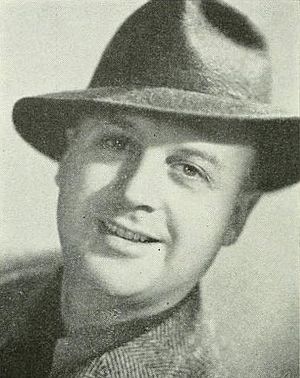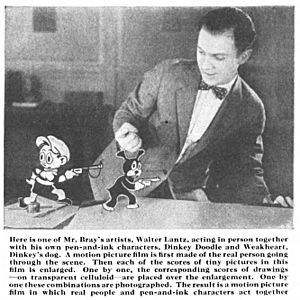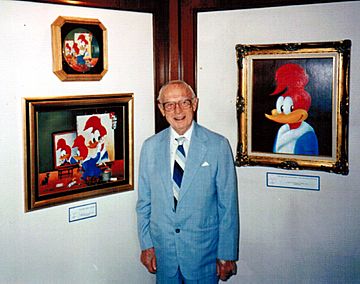Walter Lantz facts for kids
Quick facts for kids
Walter Benjamin Lantz
|
|
|---|---|

Lantz in 1939
|
|
| Born | April 27, 1899 New Rochelle, New York, U.S.
|
| Died | March 22, 1994 (aged 94) Burbank, California, U.S.
|
| Resting place | Forest Lawn Memorial Park (Hollywood Hills) |
| Occupation | Animator, producer, director, screenwriter |
| Years active | 1912–1972 |
| Employer | Walter Lantz Productions |
|
Notable work
|
Woody Woodpecker Chilly Willy Oswald the Lucky Rabbit Andy Panda |
| Television | The Woody Woodpecker Show (1957–1958) |
| Spouse(s) | |
| Awards | Academy Honorary Award 1979 Lifetime Achievement Winsor McCay Award 1973 Lifetime Achievement |
| Signature | |
 |
|
Walter Lantz (born April 27, 1899 – died March 22, 1994) was a super talented American cartoonist and animator. He was also a producer and director. Walter is most famous for starting his own company, Walter Lantz Productions, and for creating the hilarious character, Woody Woodpecker!
Contents
Walter Lantz's Amazing Life
How Walter Started in Animation

Walter Lantz was born in New Rochelle, New York. His parents were immigrants from Italy. Walter's dad used to run a grocery store.
Walter was always interested in art. When he was just 12 years old, he finished a drawing course he took by mail! He was really inspired after seeing an animated short film called "Gertie the Dinosaur" by Winsor McCay.
Walter got his first big chance while working as an auto mechanic. A rich customer named Fred Kafka saw his drawings. He liked them so much that he paid for Walter to study art in New York City.
Kafka also helped Walter get a job at a newspaper called the New York American. This newspaper was owned by William Randolph Hearst. Walter worked at the newspaper during the day and went to art school at night.
By the time he was 16, Walter was working in the animation world. He worked for a studio called International Film Service. Later, he joined John R. Bray Studios. There, he worked on a cartoon series called Jerry on the Job.
In 1924, Walter Lantz directed and animated his very own cartoon series. It was called "Dinky Doodle". This series included popular fairy tale cartoons like Cinderella (1925) and Little Red Riding Hood (1925).
Walter later moved to Hollywood, California, in 1927. He tried to start his own cartoon studio there. He also worked briefly for famous director Frank Capra. He even wrote jokes for comedies by Mack Sennett.
The Oswald the Lucky Rabbit Cartoons
In 1928, Walter Lantz got a job at Universal Pictures. He was hired to direct the Oswald the Lucky Rabbit cartoon series.
The president of Universal, Carl Laemmle, wasn't happy with the cartoons being made. He decided to produce the Oswald cartoons himself. Walter Lantz made a bet with Laemmle during a poker game. If Walter won, he would get to own the Oswald character. Walter won the bet, and Oswald became his!
Walter released his first Oswald cartoon in September 1929. It was called "Race Riot". By 1933, Oswald was fully under Lantz's control.
In 1935, Walter Lantz became an independent producer. This meant he made cartoons for Universal, but he owned his studio. By 1940, he was working to own the characters he created.
The Woody Woodpecker Era
After Oswald's popularity faded, Walter Lantz needed a new star. He and his team tried out many new characters. One character, Andy Panda, became very popular. Andy Panda was the main star for the 1939–1940 cartoon season.
The famous Woody Woodpecker first appeared in an Andy Panda cartoon. It was called Knock Knock and came out on November 25, 1940.
Less than a year later, on August 29, 1941, Walter Lantz married actress Grace Stafford. Walter said he got the idea for Woody during their honeymoon. They kept hearing a woodpecker pecking loudly on their roof! Grace suggested Walter use the bird for a cartoon character.
Walter took her advice and created Woody Woodpecker. Woody was a bold and energetic character, much like the early Daffy Duck. Woody Woodpecker quickly became a huge hit and got his own cartoon series in 1941.
Mel Blanc, a famous voice actor, did Woody's voice for the first three cartoons. When Mel Blanc started working full-time for Warner Bros., other actors voiced Woody. These included Danny Webb, Kent Rogers, and Dick Nelson.
Later, Ben Hardaway, who helped create Woody, became the bird's voice. This started with The Barber of Seville in 1944. Even with new voices, Mel Blanc's unique laugh was still used in the cartoons until 1951.
In 1948, the Lantz studio created a very popular song. It was called "The Woody Woodpecker Song". This song even featured Mel Blanc's laugh.
In 1950, Walter Lantz held auditions for a new voice for Woody. He wanted to find someone new. Grace, Walter's wife, secretly auditioned. Walter didn't know it was her, but he loved her voice! He chose Grace to be the new voice of Woody Woodpecker.
Grace voiced Woody until 1972, when the cartoons stopped being made. At first, she didn't want her name on screen. She thought people might be surprised that a woman voiced a male character. But she soon loved being known as Woody's voice. Starting in 1958, her name was shown in the credits. Grace's Woody was cuter and friendlier. The artists even changed Woody's look to match her voice.
Walter Lantz had a good relationship with Universal, the studio that released his cartoons. But this changed when Universal got new owners. The new management wanted to own the rights to Lantz's characters. Walter refused. He stopped working with Universal in late 1947.
Walter released 12 cartoons independently through United Artists in 1948 and early 1949. But he faced money problems and had to close his studio in 1949. Universal-International later made a deal with Walter. He reopened his studio and started making cartoons again in 1951.
New Directors, New Styles
Director Tex Avery was known for his wild and fast-paced cartoons. Walter Lantz convinced him to join his studio. Tex Avery directed four cartoons for Lantz in 1954–55. These included Crazy Mixed Up Pup, Sh-h-h-h-h-h, and two Chilly Willy cartoons: I'm Cold and The Legend of Rockabye Point.
Tex Avery's crazy style made the Lantz cartoons more exciting. The Legend of Rockabye Point and Crazy Mixed Up Pup were even nominated for Academy Awards.
Walter Lantz had to save money in the 1950s. He couldn't afford Tex Avery anymore. Tex Avery left the studio. This was the end of his career in making cartoons for theaters.
Later Career and Retirement
Walter Lantz brought his old cartoons to television in 1957. This was The Woody Woodpecker Show. Each episode had new live-action parts with Lantz himself. He would host the show and explain how animation works. The show first aired on ABC. It was later shown on other local stations until 1966. The Woody Woodpecker Show returned to NBC in 1970.


By the late 1960s, most other movie studios had stopped making cartoons. Walter Lantz was one of the last producers still making cartoons for theaters. He finally closed his studio in 1972. He explained that it was too expensive to keep making them.
Even in retirement, Walter Lantz continued to manage his characters. He allowed other companies to use them. He also kept drawing and painting. He sold many paintings of Woody Woodpecker.
Walter Lantz also worked with Little League and other youth groups. In 1982, he gave 17 items to the Smithsonian Institution. These included a wooden model of Woody Woodpecker from 1940. Walter and Grace also visited hospitals. Walter would draw Woody, and Grace would do Woody's famous laugh for the patients.
In 1990, Woody Woodpecker received a star on the Hollywood Walk of Fame. In 1993, Walter Lantz started a scholarship for animators. It was worth $10,000 and was named after him.
Walter Lantz passed away on March 22, 1994, at the age of 94. He died in Burbank, California.
Famous Characters
Walter Lantz created many fun characters for his cartoons and comics. Some of the most famous ones include:
- Oswald the Lucky Rabbit (from earlier years)
- Andy Panda
- The Beary Family
- Woody Woodpecker
- Chilly Willy
- Inspector Willoughby
- Wally Walrus
Awards and Honors
Walter Lantz received many awards for his amazing work:
- In 1959, the Los Angeles City Council honored him. They called him "one of America's most outstanding animated film cartoonists."
- In 1970, he received the Golden Plate Award.
- In 1973, he won the Annie Award from an international animation group.
- In 1979, he received a special Academy Honorary Award. This award was for "bringing joy and laughter to every part of the world through his unique animated motion pictures." He was only the second animator to get this special award!
- In 1986, he received a star on the Hollywood Walk of Fame.
See also
 In Spanish: Walter Lantz para niños
In Spanish: Walter Lantz para niños
- The Golden Age of American animation
- The Fantasy Film Worlds of George Pal (1985) – a documentary about George Pal where Lantz appeared.
- Walter Lantz Productions

